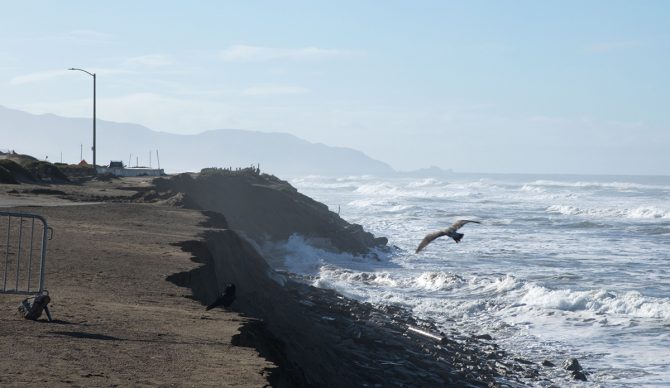
Surfrider says a seawall could drastically change the surf at the iconic Ocean Beach. Photo: Surfrider//RestoreSloat
In a contentious decision, the California Coastal Commission voted to approve a $175-million seawall project at the south end of San Francisco’s Ocean Beach. It could pose a threat to the coastline’s world-renowned waves. Surfrider Foundation had opposed the project’s design, calling for a nature-based approach via a managed retreat of vulnerable coastal infrastructure and restoration of natural dune habitat.
The project, one of the largest of its kind in California history, entails building a 3,200-foot-long buried seawall reaching 55 feet deep, running along a stretch of Ocean Beach from Sloat Boulevard to the south. San Francisco Public Utilities Commission (SFPUC) created the project to buffer the shoreline and protect a wastewater treatment station featuring a 14-foot diameter sewage tunnel. Failure of the tunnel would be catastrophic, resulting in hundreds of thousands of gallons of sewage and stormwater flowing into the ocean, according to SFPUC.
SFPUC presents the project as a long-term coastal management strategy that addresses coastal erosion problems, increases resilience to sea-level rise, and maintains public access for recreation. However, Surfrider Foundation is skeptical that the project will work as planned.
“We’re pretty disappointed,” said Mandy Sackett, Surfrider’s California Policy Coordinator. “I think the Coastal Commission was put in a really difficult position. But the fact is, every time a seawall is approved it increases the likelihood that more seawalls will be approved and the more we guarantee the loss of our beaches.”
Sackett believes that the cost of relocating the coastal-adjacent infrastructure played a key role in the Coastal Commission’s decision.
Part of the project approval includes periodic sand replenishment triggered when the beach retreats to certain width thresholds – 50 feet wide in the summer and 20 feet wide in the winter. It’s a service that the Coastal Commission estimates will cost one-million on each occasion. But Sackett points out that when a similar replenishment was done in 2021, the cost was actually seven million.
In a November 8 communication sent to the Coastal Commission, Surfrider declared that the project wouldn’t buffer the wave action at all. On the contrary, it would concentrate erosion at the wall resulting in precarious conditions for beach pedestrians.
“In our experience, oftentimes sand replenishment doesn’t work,” said Sackett. “It’s an industry based on extraction. Sand is a limited resource and what I think the people of California are likely to end up with is a giant seawall at the south end of Ocean Beach that might not remain covered for all parts of the year. We’ll lose our ability to walk the beach.”
The eroded beach would also likely affect the surf, disrupting the natural flow of sediment and creating backwash if the wall were to become exposed.
“It’s hard to predict how that will affect the surf,” said Sackett. “But we’ve seen seawalls destroy waves in other places in California, for sure.”
Sackett says that in the November 14 hearing, the Coastal Commission didn’t press the city or commission’s staff regarding the long-term implications of the project as strongly as they had hoped. Surfrider was calling for gradual coastal retreat, which was only partially met given that the plan will re-route part of the Great Highway inland. Still, the plans refuse to move the sewage tunnel or treatment plant.
Surfrider’s requests of the Coastal Commission included reducing the project’s impact by building a smaller wall further from the shoreline, running a cost-benefit analysis that considered alternatives for relocating the tunnel, restoring the dune habitat (which is not the same as laying sand on top of a seawall), and an adjustment of the planned pedestrian path that would allow for future relocation of the path and pedestrian staircases.
The project’s approval is the culmination of decades of back and forth between the City of San Francisco, the California Coastal Commission, and Surfrider. The stretch of coast already contains patches of rip rap (rocks and cement), some of which was laid by the city without permits back in the 1990s. Surfrider started its “Restore Sloat” campaign in 2010 to advocate for nature based solutions over hard infrastructure.
Despite the disappointment in the decision, Sackett insists Surfrider will remain engaged in the project.
“We’ll definitely be involved with the local and state agencies to make sure that the City is doing everything they can to comply with their permit conditions,” said Sackett. “(The conditions) include keeping the seawall covered, maintaining the beach, establishing a dune system on top of the sea wall, and hopefully just keeping the beach as contained as possible.”
Sackett says one of the key conditions in the permit requires annual reporting and a five-year commission review to determine if the project meets its success criteria of beach access, beach passability, beach use, and beach-dune connectivity. If it does not hit these benchmarks, the plan must be modified and adapted accordingly.
All relevant documents from the Coastal Commission hearing can be found here.

